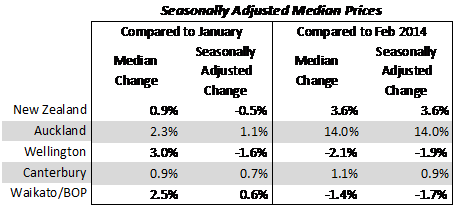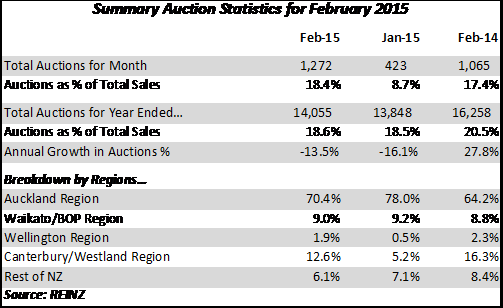Sales Volume Surge in February Real Estate Market
News Release 12 March 2015
Sales Volume Surge in February Real Estate Market
Summary
• 6,898
dwellings sold in February 2015, up 12.6% on February 2014
and up 42.5% on January
• National median price
of $430,000, up $15,000 on February 2014 and up $4,000 on
January
• A rise of 3.6% in the national median
price in the 12 months to February 2015.
• A
rise of 14.0% in Auckland’s median price, from $592,000 to
$675,000, in the same period.
• A national
median price, excluding the effect of Auckland sales, flat
at $350,000 compared to February 2014.
• 1,272
dwellings sold by auction in February, 207 more than for
February 2014.
REINZ, the most up to date source of real estate data in New Zealand, announced today that there were 6,898 dwelling sales in February 2015, up 12.6% on February 2014 and up 42.5% compared to January. This the highest February sales level since 2007.
The national median price was $430,000 for February, an increase of $15,000 or 3.6% compared to February 2014 and an increase of $4,000 or 0.9% from January.
Real Estate Institute of New Zealand (REINZ) Chief Executive Colleen Milne says, “The surge in sales volumes in February compared to January was a little stronger than is normal, but this partly reflects a catch up after there were fewer sales than expected in January.”
“The data also shows that there has been no increase in the median price for New Zealand, excluding Auckland, between February last year and February just gone. This underlines again the view that there are two distinct real estate markets in New Zealand – Auckland and the rest of the country. While politicians and policy makers focus on solutions to the Auckland region’s housing supply problems, they will also be right to reflect on the need to ensure that any national application of new policies doesn’t have an adverse effect on the rest of the country,” Milne says.
Sales
Volumes
REINZ data shows there were 6,898
unconditional residential sales in February, a 12.6%
increase on February 2014 and an increase of 42.5% from
January. On a seasonally adjusted basis the number of sales
rose 4.2% from January to February, indicating that February
sales were higher than what would normally be expected for
this time of year. This likely reflects the weaker than
expected January volume figures.
All regions recorded an increase in sales volume compared to January, with Waikato/Bay of Plenty recording the largest increase, of 61.8%, followed by Canterbury/Westland with 58.6% and Hawkes Bay with 54.3%. In comparison with February 2014, nine regions recorded increases in sales volume, with Waikato/Bay of Plenty recording the largest, of 40.6%, followed by Otago with 21.8% and Northland with 17.1%.
Prices
The national median
house price rose $4,000 (+0.9%) to $430,000 compared to
January. In comparison with February 2014 the national
median house price increased by $15,000 (+3.6%), with seven
regions recording an increase. On a seasonally adjusted
basis the national median house price eased 0.5% compared
with January and rose 3.6% compared to February
2014.

Auckland recorded the largest percentage increase in median price compared to February 2014, at 14.0%, followed by Central Otago Lakes at 12.0% and Otago at 6.8%. Compared to January, Otago recorded the largest percentage increase in median price, at 7.0%, followed by Manawatu at 5.5% and Nelson/Marlborough at 3.4%.
The REINZ Stratified Housing Price Index, which adjusts for some of the variations in the mix that can affect the median price, is 6.1% higher than in February 2014, at 4,069.7. The Auckland Index rose 15.4% compared to February 2014, the Christchurch Index 6.1% and the Wellington Index was flat.
Days To Sell
Dwellings took a
median of 41 days to sell in February, one day less than for
January and the same as for February 2014. Seven regions
saw an improvement in the number of days to sell compared to
January 2015, with Taranaki recording an improvement of 19
days, Otago 11, and Auckland and Northland two.
Otago
recorded the shortest median days to sell in February, at
31, followed by Auckland at 32 and Canterbury/Westland at
36. Northland recorded the longest median days to sell, at
72, followed by Manawatu/Wanganui at 65 and Waikato/Bay of
Plenty at 59. Over the past 10 years the median days to sell
in February has averaged 45 across New
Zealand.Auctions
There were 1,272
dwellings sold by auction nationally in February,
representing 18.4% of all sales and an increase of 207 on
the number sold by auction in February 2014. The percentage
of homes sold by auction in the 12 months to February 2015
was 18.6% (14,055 by number), compared to 20.5% (16,258 by
number) for the year ending February 2014.
Transactions in Auckland again dominated the auction market in February, representing 70% of the national total of auction sales. 37.9% of all dwelling sales in Auckland were by auction in February, compared to 31.9% in February 2014. Sales by auction in Waikato / Bay Of Plenty accounted for 9.0% of the national total, Canterbury/Westland accounted for 12.6% and all other regions combined accounted for the remaining 8.0% of the national total in February 2015.

Further Data
Across New Zealand the total value of
residential sales, including sections, was $3.801 billion in
February, compared to $2.610 billion in January and $3.171
billion in February 2014. For the 12 months ended February
2015 the total value of residential sales was $41.288
billion. The breakdown of the value of properties sold in
February 2015 compared to February 2014 is:
| February 2015 | February 2014 | |||
| $1 million plus | 577 | 8.4% | 415 | 6.8% |
| $600,000 to $999,999 | 1,439 | 20.9% | 1,169 | 19.1% |
| $400,000 to $599,999 | 1,809 | 26.2% | 1,641 | 26.2% |
| Under $400,000 | 3,073 | 44.5% | 2,900 | 47.3% |
| All Properties Sold | 6,898 | 100.0% | 6,125 | 100.0% |
There were 173 more (+6.0%) sales under $400,000 in February 2015 compared to February 2014, compared to an increase of 773 sales (+12.6%) for all price brackets between the two periods.
REINZ Stratified Median Housing Price Index
The REINZ Housing Price Index rose 0.8% compared with January to sit at 4,069.7. Auckland rose 7.3%, Christchurch 2.8% and Wellington 2.3%. For the 12 months to February the Auckland Index rose 15.4%, the Christchurch Index 6.1% and the Wellington Index was flat. The National Index increased 6.1% compared to February last year.

* CAGR is Compound Annual Growth
Rate
* The Christchurch data needs to be treated
with some caution due to compositional changes in the suburb
mix caused by the earthquakes in the city
----- ENDS -----
1. Deciles: For analysis, REINZ breaks real estate sales into 10 price bands to compare trends in prices and sales volumes across the market.
For more real
estate information and market trends data, visit
www.reinz.co.nz. For New Zealand's most
comprehensive range of listings for residential, lifestyle,
rural, commercial, investment and rental properties, visit
www.realestate.co.nz - REINZ's official
property directory website.
Editor’s
Note:
The monthly REINZ residential sales
reports remain the most contemporary and up-to-date
statistics on house prices and sales in New Zealand. They
are based on actual sales reported by real estate agents.
These sales are taken as of the date that a transaction
becomes unconditional, up to 5:00pm on the last business day
of the month. Other surveys of the residential property
market are based on information from Territorial Authorities
regarding settlement and the receipt of documents by the
relevant Territorial Authority from a solicitor. As such,
this information involves a lag of four to six weeks before
the sale is recorded.
The REINZ Monthly Housing
Price Index is calculated using a technique known as
stratification, which provides an averaging of sales prices
for common groups of houses. This approach is considered to
provide a more robust analysis of actual house price trends
and was developed in conjunction with the Reserve
Bank.
The REINZ Monthly Housing Price Index is
based on a value of 1000 in January 1992, the first month
for which electronic information is available. Changes in
the index represent movements in housing prices, where the
mix of sales between the groups is held constant and the
index is more likely to reflect genuine property price
movements.
REINZ_Residential_Regional_Data__February_2015.pdf


 Business Canterbury: Urges Council To Cut Costs, Not Ambition For City
Business Canterbury: Urges Council To Cut Costs, Not Ambition For City Wellington Airport: On Track For Net Zero Emissions By 2028
Wellington Airport: On Track For Net Zero Emissions By 2028 Landcare Research: ANZAC Gall Fly Release Promises Natural Solution To Weed Threat
Landcare Research: ANZAC Gall Fly Release Promises Natural Solution To Weed Threat NZ Anti-Vivisection Society: Auckland Rat Lovers Unite!
NZ Anti-Vivisection Society: Auckland Rat Lovers Unite! University of Canterbury: $1.35 Million Grant To Study Lion-like Jumping Spiders
University of Canterbury: $1.35 Million Grant To Study Lion-like Jumping Spiders Federated Farmers: Government Ends War On Farming
Federated Farmers: Government Ends War On Farming



